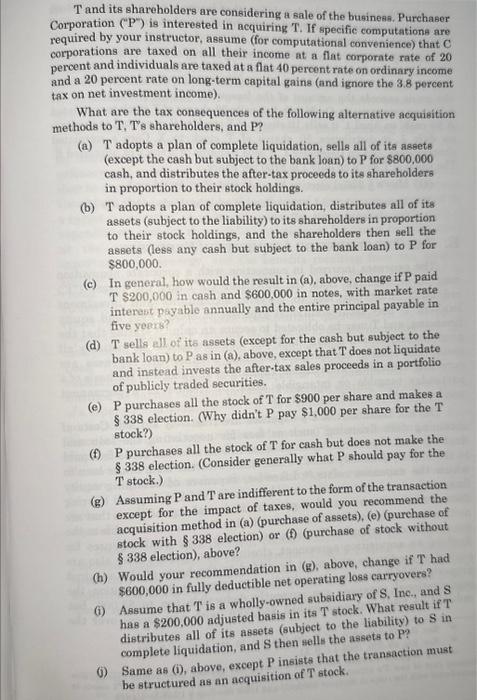Answered step by step
Verified Expert Solution
Question
1 Approved Answer
T and its shareholders are considering a sale of the business. Purchaser Corporation (P) is interested in acquiring T. If specific computations are required

T and its shareholders are considering a sale of the business. Purchaser Corporation ("P") is interested in acquiring T. If specific computations are required by your instructor, assume (for computational convenience) that C corporations are taxed on all their income at a flat corporate rate of 20 percent and individuals are taxed at a flat 40 percent rate on ordinary income and a 20 percent rate on long-term capital gains (and ignore the 3.8 percent tax on net investment income). What are the tax consequences of the following alternative acquisition methods to T, T's shareholders, and P? (a) T adopts a plan of complete liquidation, sells all of its assets (except the cash but subject to the bank loan) to P for $800,000 cash, and distributes the after-tax proceeds to its shareholders in proportion to their stock holdings. (b) T adopts a plan of complete liquidation, distributes all of its assets (subject to the liability) to its shareholders in proportion to their stock holdings, and the shareholders then sell the assets (less any cash but subject to the bank loan) to P for $800,000. (c) In general, how would the result in (a), above, change if P paid T $200,000 in cash and $600,000 in notes, with market rate interest payable annually and the entire principal payable in five years? (d) T sells all of its assets (except for the cash but subject to the bank loan) to P as in (a), above, except that T does not liquidate and instead invests the after-tax sales proceeds in a portfolio of publicly traded securities. (e) P purchases all the stock of T for $900 per share and makes a 338 election. (Why didn't P pay $1,000 per share for the T stock?) (f) P purchases all the stock of T for cash but does not make the 338 election. (Consider generally what P should pay for the T stock.) (g) Assuming P and T are indifferent to the form of the transaction except for the impact of taxes, would you recommend the acquisition method in (a) (purchase of assets), (e) (purchase of stock with 338 election) or (f) (purchase of stock without 338 election), above? (h) Would your recommendation in (g), above, change if T had $600,000 in fully deductible net operating loss carryovers? 6) Assume that T is a wholly-owned subsidiary of S, Inc., and S has a $200,000 adjusted basis in its T stock. What result if T distributes all of its assets (subject to the liability) to S in complete liquidation, and S then sells the assets to P? () Same as (i), above, except P insists that the transaction must be structured as an acquisition of T stock.
Step by Step Solution
There are 3 Steps involved in it
Step: 1

Get Instant Access to Expert-Tailored Solutions
See step-by-step solutions with expert insights and AI powered tools for academic success
Step: 2

Step: 3

Ace Your Homework with AI
Get the answers you need in no time with our AI-driven, step-by-step assistance
Get Started


